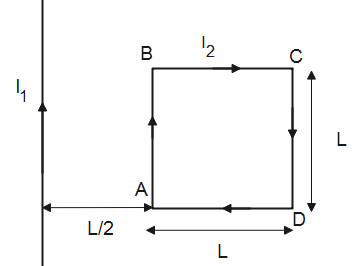
A square loop ABCD, carrying current ${{I}_{2}}$, is placed near and coplanar with a long straight conductor XY carrying a current ${{I}_{1}}$, as shown in figure. The net force on the loop will be
(A).$\dfrac{{{\mu }_{0}}{{I}_{1}}{{I}_{2}}}{2\pi }$
(B). $\dfrac{{{\mu }_{0}}{{I}_{1}}{{I}_{2}}L}{2\pi }$
(C). $\dfrac{2{{\mu }_{0}}{{I}_{1}}{{I}_{2}}}{3\pi }$
(D). $\dfrac{{{\mu }_{0}}{{I}_{1}}{{I}_{2}}}{3\pi }$


Answer
526.8k+ views
Hint: The wire and the loop both have current flowing through them and hence a magnetic field is developed due to both. The force acting between both elements depends on the currents in the wire and loops, distance between wire and loop and the length of the loop. According to the direction of force, the resultant will be the vector sum of all forces acting on the sides of the loop.
Formulas used:
$F=\dfrac{{{\mu }_{0}}{{I}_{1}}{{I}_{2}}}{2\pi r}\times l$
Complete step-by-step solution:
The force between two straight wires is given by-
$F=\dfrac{{{\mu }_{0}}{{I}_{1}}{{I}_{2}}}{2\pi r}\times l$ - (1)
Here, $F$ is the force acting between the wires
${{\mu }_{0}}$ is the permeability of free space
${{I}_{1}}$ is the current in one wire
${{I}_{2}}$ is the current flowing through the second wire
$l$ is the length of the element on which the force acts
$r$ is the distance between the wires
The force acting on AD and BC is equal and opposite and hence will cancel out each other.
The force acting on AB will be, from eq (1),
$\begin{align}
& {{F}_{1}}=\dfrac{{{\mu }_{0}}{{I}_{1}}{{I}_{2}}}{2\pi \dfrac{L}{2}}L \\
& \Rightarrow {{F}_{1}}=\dfrac{2{{\mu }_{0}}{{I}_{1}}{{I}_{2}}}{2\pi } \\
\end{align}$
The force acting on DC will be, from eq (1),
$\begin{align}
& {{F}_{2}}=\dfrac{{{\mu }_{0}}{{I}_{1}}{{I}_{2}}}{2\pi \left( L+\dfrac{L}{2} \right)}L \\
& \Rightarrow {{F}_{2}}=\dfrac{2{{\mu }_{0}}{{I}_{1}}{{I}_{2}}}{2\pi (3)} \\
\end{align}$
Using the right hand thumb rule which states that if the thumb represent the current in a straight wire, then the fingers represent the direction of magnetic field, the direction of force on AB and DC is different, therefore, the total force on the loop due to the straight wire is-
$F={{F}_{1}}-{{F}_{2}}$
We substitute values in the above equation to get,
$\begin{align}
& F=\dfrac{2{{\mu }_{0}}{{I}_{1}}{{I}_{2}}}{2\pi }-\dfrac{2{{\mu }_{0}}{{I}_{1}}{{I}_{2}}}{2\pi (3)} \\
& \Rightarrow F=\dfrac{2{{\mu }_{0}}{{I}_{1}}{{I}_{2}}}{3\pi } \\
\end{align}$
Therefore, the total force acting on the loop is $\dfrac{2{{\mu }_{0}}{{I}_{1}}{{I}_{2}}}{3\pi }$. Hence, the correct option is (C).
Note: Since the current in the loop is flowing in the clockwise direction, a south pole is formed. While the magnetic field due to the current in the wire is in the plane of the paper for the loop, hence a north pole is formed. Therefore, a resultant attractive force exists between the wire and loop.
Formulas used:
$F=\dfrac{{{\mu }_{0}}{{I}_{1}}{{I}_{2}}}{2\pi r}\times l$
Complete step-by-step solution:
The force between two straight wires is given by-
$F=\dfrac{{{\mu }_{0}}{{I}_{1}}{{I}_{2}}}{2\pi r}\times l$ - (1)
Here, $F$ is the force acting between the wires
${{\mu }_{0}}$ is the permeability of free space
${{I}_{1}}$ is the current in one wire
${{I}_{2}}$ is the current flowing through the second wire
$l$ is the length of the element on which the force acts
$r$ is the distance between the wires
The force acting on AD and BC is equal and opposite and hence will cancel out each other.
The force acting on AB will be, from eq (1),
$\begin{align}
& {{F}_{1}}=\dfrac{{{\mu }_{0}}{{I}_{1}}{{I}_{2}}}{2\pi \dfrac{L}{2}}L \\
& \Rightarrow {{F}_{1}}=\dfrac{2{{\mu }_{0}}{{I}_{1}}{{I}_{2}}}{2\pi } \\
\end{align}$
The force acting on DC will be, from eq (1),
$\begin{align}
& {{F}_{2}}=\dfrac{{{\mu }_{0}}{{I}_{1}}{{I}_{2}}}{2\pi \left( L+\dfrac{L}{2} \right)}L \\
& \Rightarrow {{F}_{2}}=\dfrac{2{{\mu }_{0}}{{I}_{1}}{{I}_{2}}}{2\pi (3)} \\
\end{align}$
Using the right hand thumb rule which states that if the thumb represent the current in a straight wire, then the fingers represent the direction of magnetic field, the direction of force on AB and DC is different, therefore, the total force on the loop due to the straight wire is-
$F={{F}_{1}}-{{F}_{2}}$
We substitute values in the above equation to get,
$\begin{align}
& F=\dfrac{2{{\mu }_{0}}{{I}_{1}}{{I}_{2}}}{2\pi }-\dfrac{2{{\mu }_{0}}{{I}_{1}}{{I}_{2}}}{2\pi (3)} \\
& \Rightarrow F=\dfrac{2{{\mu }_{0}}{{I}_{1}}{{I}_{2}}}{3\pi } \\
\end{align}$
Therefore, the total force acting on the loop is $\dfrac{2{{\mu }_{0}}{{I}_{1}}{{I}_{2}}}{3\pi }$. Hence, the correct option is (C).
Note: Since the current in the loop is flowing in the clockwise direction, a south pole is formed. While the magnetic field due to the current in the wire is in the plane of the paper for the loop, hence a north pole is formed. Therefore, a resultant attractive force exists between the wire and loop.
Recently Updated Pages
Basicity of sulphurous acid and sulphuric acid are

Master Class 12 Business Studies: Engaging Questions & Answers for Success

Master Class 12 Economics: Engaging Questions & Answers for Success

Master Class 12 English: Engaging Questions & Answers for Success

Master Class 12 Maths: Engaging Questions & Answers for Success

Master Class 12 Social Science: Engaging Questions & Answers for Success

Trending doubts
What are the major means of transport Explain each class 12 social science CBSE

Which are the Top 10 Largest Countries of the World?

Draw a labelled sketch of the human eye class 12 physics CBSE

How much time does it take to bleed after eating p class 12 biology CBSE

Explain sex determination in humans with line diag class 12 biology CBSE

Differentiate between homogeneous and heterogeneous class 12 chemistry CBSE




